Eagle Academy: BSB INM 601 Knowledge & Information Management
VerifiedAdded on 2023/06/13
|23
|8043
|252
Homework Assignment
AI Summary
This assignment solution for BSB INM 601 Knowledge and Information Management covers topics such as existing and emerging technologies relevant to fitness centers, statistical analysis methods including dynamic programming, linear programming and queuing theory, management information systems, decision support systems, and risk management plans. It includes a case study analysis of Bounce Fitness, defining business problems and proposing ideal solutions through strategic and operational questions. The solution references various research sources related to queuing systems, dynamic programming, personal training, and the fitness industry in Australia, providing a comprehensive overview of knowledge and information management principles within a business context.
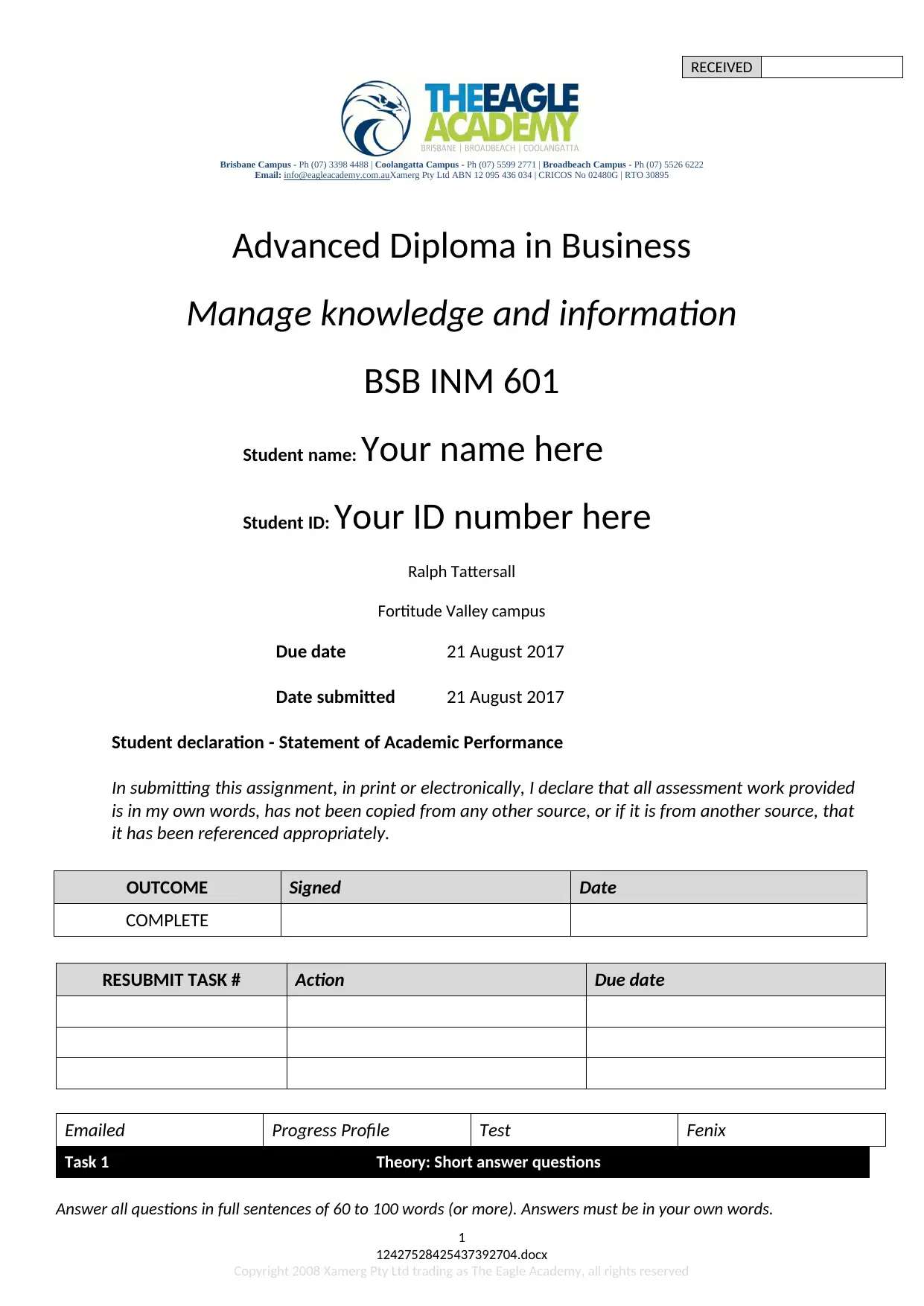
RECEIVED
Brisbane Campus - Ph (07) 3398 4488 | Coolangatta Campus - Ph (07) 5599 2771 | Broadbeach Campus - Ph (07) 5526 6222
Email: info@eagleacademy.com.auXamerg Pty Ltd ABN 12 095 436 034 | CRICOS No 02480G | RTO 30895
Advanced Diploma in Business
Manage knowledge and information
BSB INM 601
Student name: Your name here
Student ID: Your ID number here
Ralph Tattersall
Fortitude Valley campus
Due date 21 August 2017
Date submitted 21 August 2017
Student declaration - Statement of Academic Performance
In submitting this assignment, in print or electronically, I declare that all assessment work provided
is in my own words, has not been copied from any other source, or if it is from another source, that
it has been referenced appropriately.
OUTCOME Signed Date
COMPLETE
RESUBMIT TASK # Action Due date
Emailed Progress Profile Test Fenix
Task 1 Theory: Short answer questions
Answer all questions in full sentences of 60 to 100 words (or more). Answers must be in your own words.
1
12427528425437392704.docx
Copyright 2008 Xamerg Pty Ltd trading as The Eagle Academy, all rights reserved
Brisbane Campus - Ph (07) 3398 4488 | Coolangatta Campus - Ph (07) 5599 2771 | Broadbeach Campus - Ph (07) 5526 6222
Email: info@eagleacademy.com.auXamerg Pty Ltd ABN 12 095 436 034 | CRICOS No 02480G | RTO 30895
Advanced Diploma in Business
Manage knowledge and information
BSB INM 601
Student name: Your name here
Student ID: Your ID number here
Ralph Tattersall
Fortitude Valley campus
Due date 21 August 2017
Date submitted 21 August 2017
Student declaration - Statement of Academic Performance
In submitting this assignment, in print or electronically, I declare that all assessment work provided
is in my own words, has not been copied from any other source, or if it is from another source, that
it has been referenced appropriately.
OUTCOME Signed Date
COMPLETE
RESUBMIT TASK # Action Due date
Emailed Progress Profile Test Fenix
Task 1 Theory: Short answer questions
Answer all questions in full sentences of 60 to 100 words (or more). Answers must be in your own words.
1
12427528425437392704.docx
Copyright 2008 Xamerg Pty Ltd trading as The Eagle Academy, all rights reserved
Paraphrase This Document
Need a fresh take? Get an instant paraphrase of this document with our AI Paraphraser

1a.
KE 1
Technologies
Give at least two examples of existing and emerging technologies which are relevant to fitness
centres. For each technology, explain how they are useful for managing knowledge and information.
Answer i. Nanotechnology
ii. Advanced computer systems
iii. Advanced medical and scientific knowledge
Answer Nanotechnology- Microscopic manipulation of biological processes.
Advanced computer systems- Translate human intellect and imitate complex skills.
Advanced medical and scientific knowledge- Inventions and innovations of new ideas and
information (Kearney, 2017).
1b.
KE 2
Statistical analysis and quantitative methods
Define and describe the use of any three of the following statistical analysis and quantitative
methods:
Correlation calculations
Long-term trend analyses
Probability assessment
Regulation analyses
Short to medium trend analyses
Dynamic programming
Linear programming
Queuing theory
Simulation
Transportation methodology.
Conduct research additional to your reading and include the URL of each source accessed.
Answer Dynamic theory- simplifies an intricate problem into a comprehensive solution. It helps in estimating
the optimum rate of resource consumption and saving depending (Bellman, 2013).
Linear programming- is based on acquisition of the most favourable results in a numerical
ideal. It aids in designing various issues in processes like preparation, repulsing, organizing and task
performance in management systems (Kulturel-Konak & Konak).
Queuing theory- involves lag dilemmas and daily positions affecting cases like reconstruction
projects. Fitness centres use the theory for time management (Al-Matar, 2017).
1c.
KE 3
Management information systems
Define management information systems and outline three or more key features of these.
Conduct research additional to your reading and include the URL of each source accessed.
Answer The Management Information Systems are unified consumer devices that transfer instructions for
supporting business structure (Jansen, Curşeu, Vermeulen, Geurts& Gibcus, 2013). Key features
2
12427528425437392704.docx
Copyright 2008 Xamerg Pty Ltd trading as The Eagle Academy, all rights reserved
KE 1
Technologies
Give at least two examples of existing and emerging technologies which are relevant to fitness
centres. For each technology, explain how they are useful for managing knowledge and information.
Answer i. Nanotechnology
ii. Advanced computer systems
iii. Advanced medical and scientific knowledge
Answer Nanotechnology- Microscopic manipulation of biological processes.
Advanced computer systems- Translate human intellect and imitate complex skills.
Advanced medical and scientific knowledge- Inventions and innovations of new ideas and
information (Kearney, 2017).
1b.
KE 2
Statistical analysis and quantitative methods
Define and describe the use of any three of the following statistical analysis and quantitative
methods:
Correlation calculations
Long-term trend analyses
Probability assessment
Regulation analyses
Short to medium trend analyses
Dynamic programming
Linear programming
Queuing theory
Simulation
Transportation methodology.
Conduct research additional to your reading and include the URL of each source accessed.
Answer Dynamic theory- simplifies an intricate problem into a comprehensive solution. It helps in estimating
the optimum rate of resource consumption and saving depending (Bellman, 2013).
Linear programming- is based on acquisition of the most favourable results in a numerical
ideal. It aids in designing various issues in processes like preparation, repulsing, organizing and task
performance in management systems (Kulturel-Konak & Konak).
Queuing theory- involves lag dilemmas and daily positions affecting cases like reconstruction
projects. Fitness centres use the theory for time management (Al-Matar, 2017).
1c.
KE 3
Management information systems
Define management information systems and outline three or more key features of these.
Conduct research additional to your reading and include the URL of each source accessed.
Answer The Management Information Systems are unified consumer devices that transfer instructions for
supporting business structure (Jansen, Curşeu, Vermeulen, Geurts& Gibcus, 2013). Key features
2
12427528425437392704.docx
Copyright 2008 Xamerg Pty Ltd trading as The Eagle Academy, all rights reserved

include:
Information must precise, appropriate and advanced.
Data presentation should be in the most suitable format of charts or tables.
Flexibility (Islam, Kwak, Kabir, Hossain, & Kwak, 2015).
1d.
KE 3
Decision support systems
Define decision support systems and outline three or more key features of these.
Conduct research additional to your reading and include the URL of each source accessed.
Answer Decision Support Systems refers to the application of electronic devices like computers for official
decision making and effective managerial activities (Power, 2015). key features:
Structured or unstructured decision framework.
Backing decision makers rather than their substitution.
Target effectiveness rather than efficiency.
1e.
KE 4
Risk management plans
Describe how risk management plans are used to determine an organisation’s acceptable course of
action.
Answer A standardized liability management for business action involves recognition of risk, liability
assessment, control of the risk, progress authentication and case review (Keyzer, Coyle, Dietrich,
Norton, Sekendiz, Jones & Finch, 2014).
3
12427528425437392704.docx
Copyright 2008 Xamerg Pty Ltd trading as The Eagle Academy, all rights reserved
Information must precise, appropriate and advanced.
Data presentation should be in the most suitable format of charts or tables.
Flexibility (Islam, Kwak, Kabir, Hossain, & Kwak, 2015).
1d.
KE 3
Decision support systems
Define decision support systems and outline three or more key features of these.
Conduct research additional to your reading and include the URL of each source accessed.
Answer Decision Support Systems refers to the application of electronic devices like computers for official
decision making and effective managerial activities (Power, 2015). key features:
Structured or unstructured decision framework.
Backing decision makers rather than their substitution.
Target effectiveness rather than efficiency.
1e.
KE 4
Risk management plans
Describe how risk management plans are used to determine an organisation’s acceptable course of
action.
Answer A standardized liability management for business action involves recognition of risk, liability
assessment, control of the risk, progress authentication and case review (Keyzer, Coyle, Dietrich,
Norton, Sekendiz, Jones & Finch, 2014).
3
12427528425437392704.docx
Copyright 2008 Xamerg Pty Ltd trading as The Eagle Academy, all rights reserved
⊘ This is a preview!⊘
Do you want full access?
Subscribe today to unlock all pages.

Trusted by 1+ million students worldwide
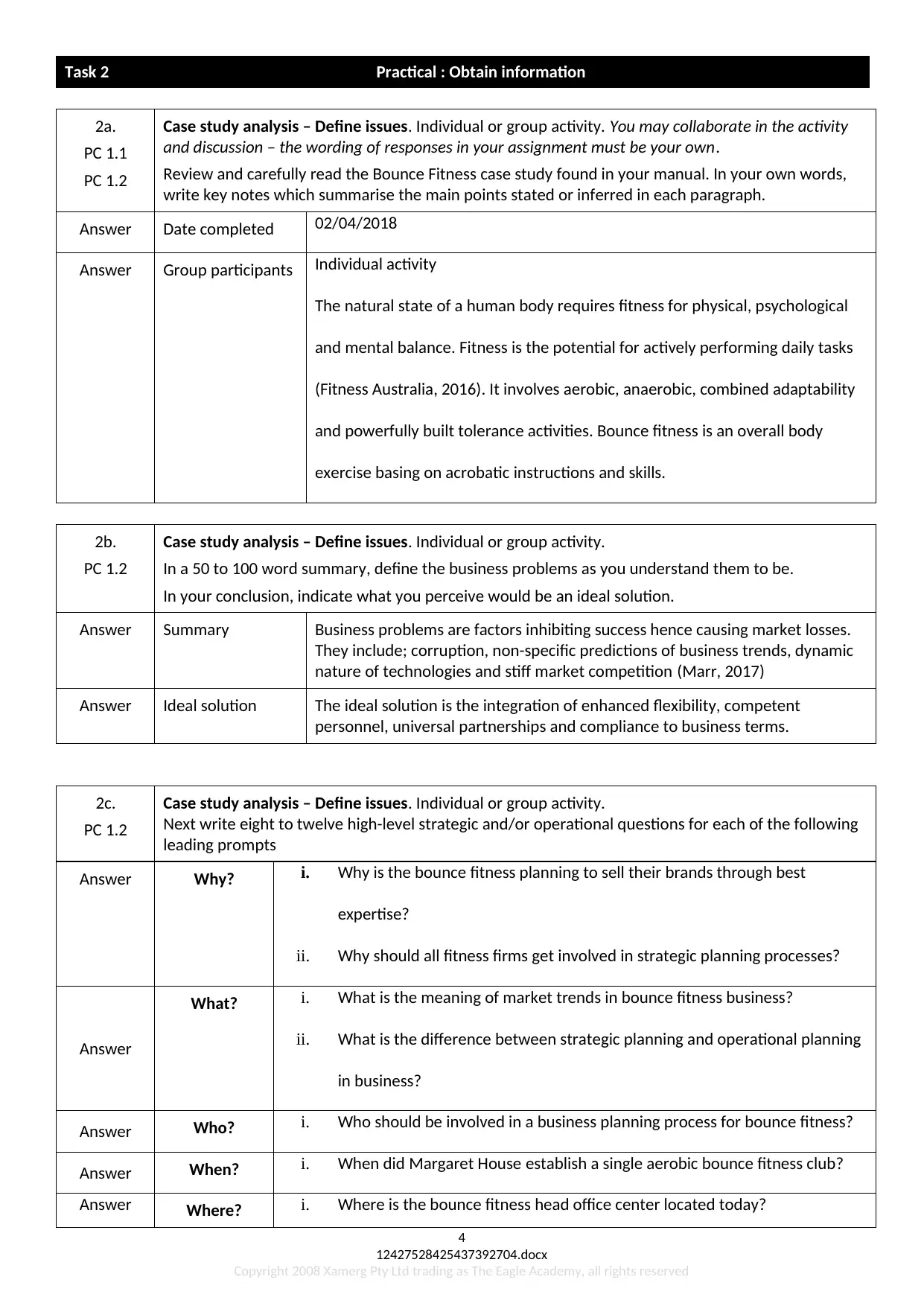
Task 2 Practical : Obtain information
2a.
PC 1.1
PC 1.2
Case study analysis – Define issues. Individual or group activity. You may collaborate in the activity
and discussion – the wording of responses in your assignment must be your own.
Review and carefully read the Bounce Fitness case study found in your manual. In your own words,
write key notes which summarise the main points stated or inferred in each paragraph.
Answer Date completed 02/04/2018
Answer Group participants Individual activity
The natural state of a human body requires fitness for physical, psychological
and mental balance. Fitness is the potential for actively performing daily tasks
(Fitness Australia, 2016). It involves aerobic, anaerobic, combined adaptability
and powerfully built tolerance activities. Bounce fitness is an overall body
exercise basing on acrobatic instructions and skills.
2b.
PC 1.2
Case study analysis – Define issues. Individual or group activity.
In a 50 to 100 word summary, define the business problems as you understand them to be.
In your conclusion, indicate what you perceive would be an ideal solution.
Answer Summary Business problems are factors inhibiting success hence causing market losses.
They include; corruption, non-specific predictions of business trends, dynamic
nature of technologies and stiff market competition (Marr, 2017)
Answer Ideal solution The ideal solution is the integration of enhanced flexibility, competent
personnel, universal partnerships and compliance to business terms.
2c.
PC 1.2
Case study analysis – Define issues. Individual or group activity.
Next write eight to twelve high-level strategic and/or operational questions for each of the following
leading prompts
Answer Why? i. Why is the bounce fitness planning to sell their brands through best
expertise?
ii. Why should all fitness firms get involved in strategic planning processes?
Answer
What? i. What is the meaning of market trends in bounce fitness business?
ii. What is the difference between strategic planning and operational planning
in business?
Answer Who? i. Who should be involved in a business planning process for bounce fitness?
Answer When? i. When did Margaret House establish a single aerobic bounce fitness club?
Answer Where? i. Where is the bounce fitness head office center located today?
4
12427528425437392704.docx
Copyright 2008 Xamerg Pty Ltd trading as The Eagle Academy, all rights reserved
2a.
PC 1.1
PC 1.2
Case study analysis – Define issues. Individual or group activity. You may collaborate in the activity
and discussion – the wording of responses in your assignment must be your own.
Review and carefully read the Bounce Fitness case study found in your manual. In your own words,
write key notes which summarise the main points stated or inferred in each paragraph.
Answer Date completed 02/04/2018
Answer Group participants Individual activity
The natural state of a human body requires fitness for physical, psychological
and mental balance. Fitness is the potential for actively performing daily tasks
(Fitness Australia, 2016). It involves aerobic, anaerobic, combined adaptability
and powerfully built tolerance activities. Bounce fitness is an overall body
exercise basing on acrobatic instructions and skills.
2b.
PC 1.2
Case study analysis – Define issues. Individual or group activity.
In a 50 to 100 word summary, define the business problems as you understand them to be.
In your conclusion, indicate what you perceive would be an ideal solution.
Answer Summary Business problems are factors inhibiting success hence causing market losses.
They include; corruption, non-specific predictions of business trends, dynamic
nature of technologies and stiff market competition (Marr, 2017)
Answer Ideal solution The ideal solution is the integration of enhanced flexibility, competent
personnel, universal partnerships and compliance to business terms.
2c.
PC 1.2
Case study analysis – Define issues. Individual or group activity.
Next write eight to twelve high-level strategic and/or operational questions for each of the following
leading prompts
Answer Why? i. Why is the bounce fitness planning to sell their brands through best
expertise?
ii. Why should all fitness firms get involved in strategic planning processes?
Answer
What? i. What is the meaning of market trends in bounce fitness business?
ii. What is the difference between strategic planning and operational planning
in business?
Answer Who? i. Who should be involved in a business planning process for bounce fitness?
Answer When? i. When did Margaret House establish a single aerobic bounce fitness club?
Answer Where? i. Where is the bounce fitness head office center located today?
4
12427528425437392704.docx
Copyright 2008 Xamerg Pty Ltd trading as The Eagle Academy, all rights reserved
Paraphrase This Document
Need a fresh take? Get an instant paraphrase of this document with our AI Paraphraser
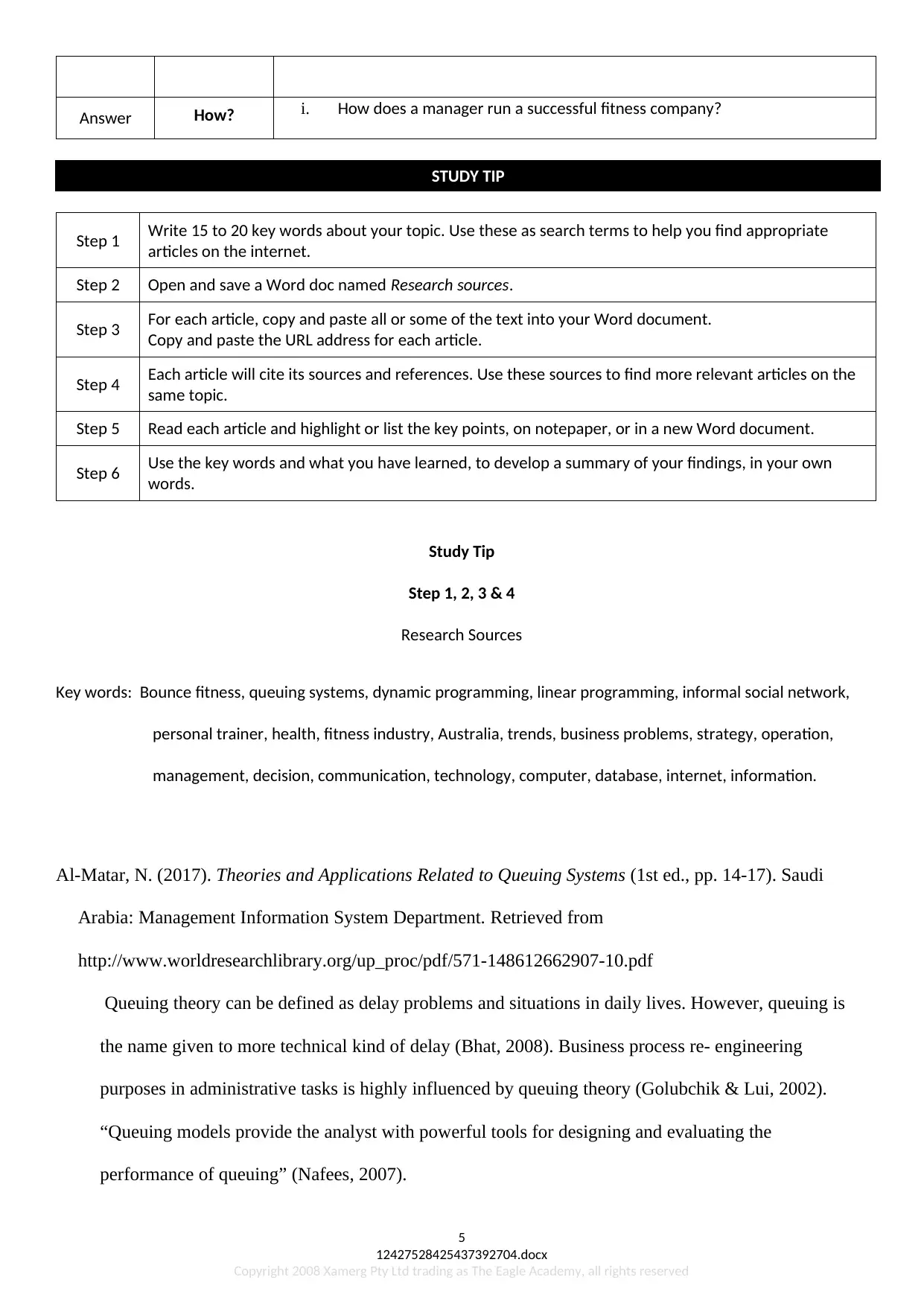
Answer How? i. How does a manager run a successful fitness company?
STUDY TIP
Step 1 Write 15 to 20 key words about your topic. Use these as search terms to help you find appropriate
articles on the internet.
Step 2 Open and save a Word doc named Research sources.
Step 3 For each article, copy and paste all or some of the text into your Word document.
Copy and paste the URL address for each article.
Step 4 Each article will cite its sources and references. Use these sources to find more relevant articles on the
same topic.
Step 5 Read each article and highlight or list the key points, on notepaper, or in a new Word document.
Step 6 Use the key words and what you have learned, to develop a summary of your findings, in your own
words.
Study Tip
Step 1, 2, 3 & 4
Research Sources
Key words: Bounce fitness, queuing systems, dynamic programming, linear programming, informal social network,
personal trainer, health, fitness industry, Australia, trends, business problems, strategy, operation,
management, decision, communication, technology, computer, database, internet, information.
Al-Matar, N. (2017). Theories and Applications Related to Queuing Systems (1st ed., pp. 14-17). Saudi
Arabia: Management Information System Department. Retrieved from
http://www.worldresearchlibrary.org/up_proc/pdf/571-148612662907-10.pdf
Queuing theory can be defined as delay problems and situations in daily lives. However, queuing is
the name given to more technical kind of delay (Bhat, 2008). Business process re- engineering
purposes in administrative tasks is highly influenced by queuing theory (Golubchik & Lui, 2002).
“Queuing models provide the analyst with powerful tools for designing and evaluating the
performance of queuing” (Nafees, 2007).
5
12427528425437392704.docx
Copyright 2008 Xamerg Pty Ltd trading as The Eagle Academy, all rights reserved
STUDY TIP
Step 1 Write 15 to 20 key words about your topic. Use these as search terms to help you find appropriate
articles on the internet.
Step 2 Open and save a Word doc named Research sources.
Step 3 For each article, copy and paste all or some of the text into your Word document.
Copy and paste the URL address for each article.
Step 4 Each article will cite its sources and references. Use these sources to find more relevant articles on the
same topic.
Step 5 Read each article and highlight or list the key points, on notepaper, or in a new Word document.
Step 6 Use the key words and what you have learned, to develop a summary of your findings, in your own
words.
Study Tip
Step 1, 2, 3 & 4
Research Sources
Key words: Bounce fitness, queuing systems, dynamic programming, linear programming, informal social network,
personal trainer, health, fitness industry, Australia, trends, business problems, strategy, operation,
management, decision, communication, technology, computer, database, internet, information.
Al-Matar, N. (2017). Theories and Applications Related to Queuing Systems (1st ed., pp. 14-17). Saudi
Arabia: Management Information System Department. Retrieved from
http://www.worldresearchlibrary.org/up_proc/pdf/571-148612662907-10.pdf
Queuing theory can be defined as delay problems and situations in daily lives. However, queuing is
the name given to more technical kind of delay (Bhat, 2008). Business process re- engineering
purposes in administrative tasks is highly influenced by queuing theory (Golubchik & Lui, 2002).
“Queuing models provide the analyst with powerful tools for designing and evaluating the
performance of queuing” (Nafees, 2007).
5
12427528425437392704.docx
Copyright 2008 Xamerg Pty Ltd trading as The Eagle Academy, all rights reserved
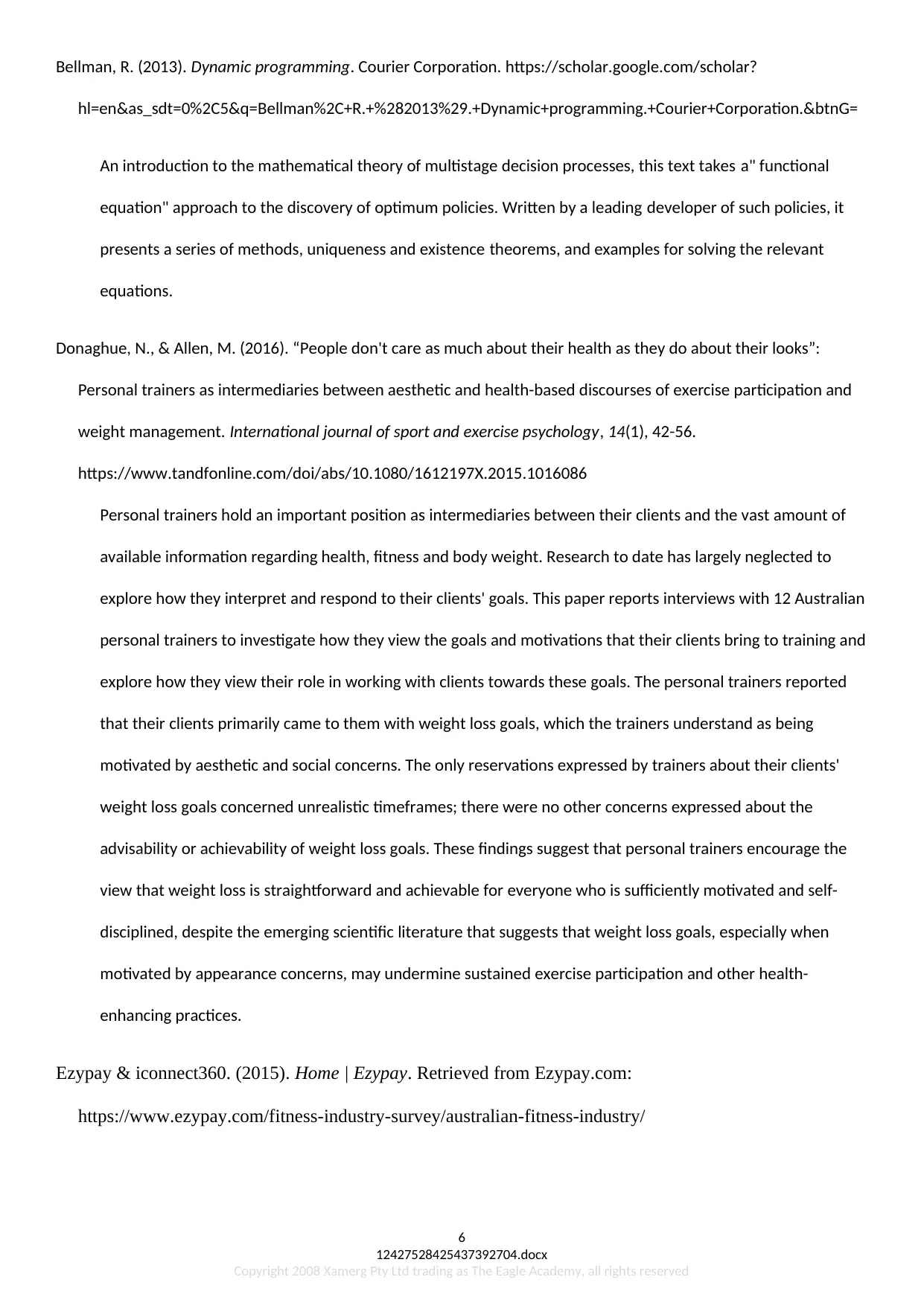
Bellman, R. (2013). Dynamic programming. Courier Corporation. https://scholar.google.com/scholar?
hl=en&as_sdt=0%2C5&q=Bellman%2C+R.+%282013%29.+Dynamic+programming.+Courier+Corporation.&btnG=
An introduction to the mathematical theory of multistage decision processes, this text takes a" functional
equation" approach to the discovery of optimum policies. Written by a leading developer of such policies, it
presents a series of methods, uniqueness and existence theorems, and examples for solving the relevant
equations.
Donaghue, N., & Allen, M. (2016). “People don't care as much about their health as they do about their looks”:
Personal trainers as intermediaries between aesthetic and health-based discourses of exercise participation and
weight management. International journal of sport and exercise psychology, 14(1), 42-56.
https://www.tandfonline.com/doi/abs/10.1080/1612197X.2015.1016086
Personal trainers hold an important position as intermediaries between their clients and the vast amount of
available information regarding health, fitness and body weight. Research to date has largely neglected to
explore how they interpret and respond to their clients' goals. This paper reports interviews with 12 Australian
personal trainers to investigate how they view the goals and motivations that their clients bring to training and
explore how they view their role in working with clients towards these goals. The personal trainers reported
that their clients primarily came to them with weight loss goals, which the trainers understand as being
motivated by aesthetic and social concerns. The only reservations expressed by trainers about their clients'
weight loss goals concerned unrealistic timeframes; there were no other concerns expressed about the
advisability or achievability of weight loss goals. These findings suggest that personal trainers encourage the
view that weight loss is straightforward and achievable for everyone who is sufficiently motivated and self-
disciplined, despite the emerging scientific literature that suggests that weight loss goals, especially when
motivated by appearance concerns, may undermine sustained exercise participation and other health-
enhancing practices.
Ezypay & iconnect360. (2015). Home | Ezypay. Retrieved from Ezypay.com:
https://www.ezypay.com/fitness-industry-survey/australian-fitness-industry/
6
12427528425437392704.docx
Copyright 2008 Xamerg Pty Ltd trading as The Eagle Academy, all rights reserved
hl=en&as_sdt=0%2C5&q=Bellman%2C+R.+%282013%29.+Dynamic+programming.+Courier+Corporation.&btnG=
An introduction to the mathematical theory of multistage decision processes, this text takes a" functional
equation" approach to the discovery of optimum policies. Written by a leading developer of such policies, it
presents a series of methods, uniqueness and existence theorems, and examples for solving the relevant
equations.
Donaghue, N., & Allen, M. (2016). “People don't care as much about their health as they do about their looks”:
Personal trainers as intermediaries between aesthetic and health-based discourses of exercise participation and
weight management. International journal of sport and exercise psychology, 14(1), 42-56.
https://www.tandfonline.com/doi/abs/10.1080/1612197X.2015.1016086
Personal trainers hold an important position as intermediaries between their clients and the vast amount of
available information regarding health, fitness and body weight. Research to date has largely neglected to
explore how they interpret and respond to their clients' goals. This paper reports interviews with 12 Australian
personal trainers to investigate how they view the goals and motivations that their clients bring to training and
explore how they view their role in working with clients towards these goals. The personal trainers reported
that their clients primarily came to them with weight loss goals, which the trainers understand as being
motivated by aesthetic and social concerns. The only reservations expressed by trainers about their clients'
weight loss goals concerned unrealistic timeframes; there were no other concerns expressed about the
advisability or achievability of weight loss goals. These findings suggest that personal trainers encourage the
view that weight loss is straightforward and achievable for everyone who is sufficiently motivated and self-
disciplined, despite the emerging scientific literature that suggests that weight loss goals, especially when
motivated by appearance concerns, may undermine sustained exercise participation and other health-
enhancing practices.
Ezypay & iconnect360. (2015). Home | Ezypay. Retrieved from Ezypay.com:
https://www.ezypay.com/fitness-industry-survey/australian-fitness-industry/
6
12427528425437392704.docx
Copyright 2008 Xamerg Pty Ltd trading as The Eagle Academy, all rights reserved
⊘ This is a preview!⊘
Do you want full access?
Subscribe today to unlock all pages.

Trusted by 1+ million students worldwide
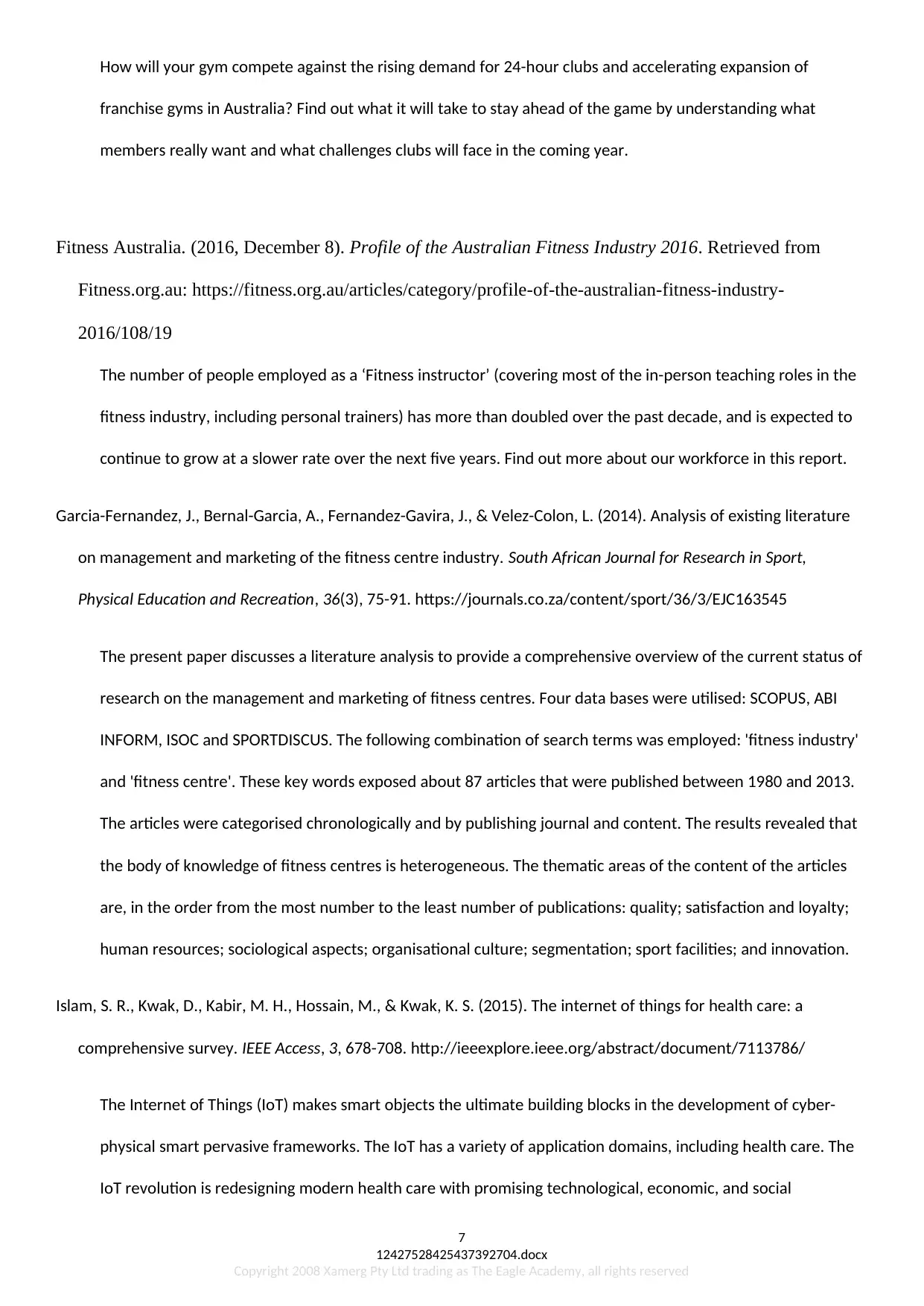
How will your gym compete against the rising demand for 24-hour clubs and accelerating expansion of
franchise gyms in Australia? Find out what it will take to stay ahead of the game by understanding what
members really want and what challenges clubs will face in the coming year.
Fitness Australia. (2016, December 8). Profile of the Australian Fitness Industry 2016. Retrieved from
Fitness.org.au: https://fitness.org.au/articles/category/profile-of-the-australian-fitness-industry-
2016/108/19
The number of people employed as a ‘Fitness instructor’ (covering most of the in-person teaching roles in the
fitness industry, including personal trainers) has more than doubled over the past decade, and is expected to
continue to grow at a slower rate over the next five years. Find out more about our workforce in this report.
Garcia-Fernandez, J., Bernal-Garcia, A., Fernandez-Gavira, J., & Velez-Colon, L. (2014). Analysis of existing literature
on management and marketing of the fitness centre industry. South African Journal for Research in Sport,
Physical Education and Recreation, 36(3), 75-91. https://journals.co.za/content/sport/36/3/EJC163545
The present paper discusses a literature analysis to provide a comprehensive overview of the current status of
research on the management and marketing of fitness centres. Four data bases were utilised: SCOPUS, ABI
INFORM, ISOC and SPORTDISCUS. The following combination of search terms was employed: 'fitness industry'
and 'fitness centre'. These key words exposed about 87 articles that were published between 1980 and 2013.
The articles were categorised chronologically and by publishing journal and content. The results revealed that
the body of knowledge of fitness centres is heterogeneous. The thematic areas of the content of the articles
are, in the order from the most number to the least number of publications: quality; satisfaction and loyalty;
human resources; sociological aspects; organisational culture; segmentation; sport facilities; and innovation.
Islam, S. R., Kwak, D., Kabir, M. H., Hossain, M., & Kwak, K. S. (2015). The internet of things for health care: a
comprehensive survey. IEEE Access, 3, 678-708. http://ieeexplore.ieee.org/abstract/document/7113786/
The Internet of Things (IoT) makes smart objects the ultimate building blocks in the development of cyber-
physical smart pervasive frameworks. The IoT has a variety of application domains, including health care. The
IoT revolution is redesigning modern health care with promising technological, economic, and social
7
12427528425437392704.docx
Copyright 2008 Xamerg Pty Ltd trading as The Eagle Academy, all rights reserved
franchise gyms in Australia? Find out what it will take to stay ahead of the game by understanding what
members really want and what challenges clubs will face in the coming year.
Fitness Australia. (2016, December 8). Profile of the Australian Fitness Industry 2016. Retrieved from
Fitness.org.au: https://fitness.org.au/articles/category/profile-of-the-australian-fitness-industry-
2016/108/19
The number of people employed as a ‘Fitness instructor’ (covering most of the in-person teaching roles in the
fitness industry, including personal trainers) has more than doubled over the past decade, and is expected to
continue to grow at a slower rate over the next five years. Find out more about our workforce in this report.
Garcia-Fernandez, J., Bernal-Garcia, A., Fernandez-Gavira, J., & Velez-Colon, L. (2014). Analysis of existing literature
on management and marketing of the fitness centre industry. South African Journal for Research in Sport,
Physical Education and Recreation, 36(3), 75-91. https://journals.co.za/content/sport/36/3/EJC163545
The present paper discusses a literature analysis to provide a comprehensive overview of the current status of
research on the management and marketing of fitness centres. Four data bases were utilised: SCOPUS, ABI
INFORM, ISOC and SPORTDISCUS. The following combination of search terms was employed: 'fitness industry'
and 'fitness centre'. These key words exposed about 87 articles that were published between 1980 and 2013.
The articles were categorised chronologically and by publishing journal and content. The results revealed that
the body of knowledge of fitness centres is heterogeneous. The thematic areas of the content of the articles
are, in the order from the most number to the least number of publications: quality; satisfaction and loyalty;
human resources; sociological aspects; organisational culture; segmentation; sport facilities; and innovation.
Islam, S. R., Kwak, D., Kabir, M. H., Hossain, M., & Kwak, K. S. (2015). The internet of things for health care: a
comprehensive survey. IEEE Access, 3, 678-708. http://ieeexplore.ieee.org/abstract/document/7113786/
The Internet of Things (IoT) makes smart objects the ultimate building blocks in the development of cyber-
physical smart pervasive frameworks. The IoT has a variety of application domains, including health care. The
IoT revolution is redesigning modern health care with promising technological, economic, and social
7
12427528425437392704.docx
Copyright 2008 Xamerg Pty Ltd trading as The Eagle Academy, all rights reserved
Paraphrase This Document
Need a fresh take? Get an instant paraphrase of this document with our AI Paraphraser
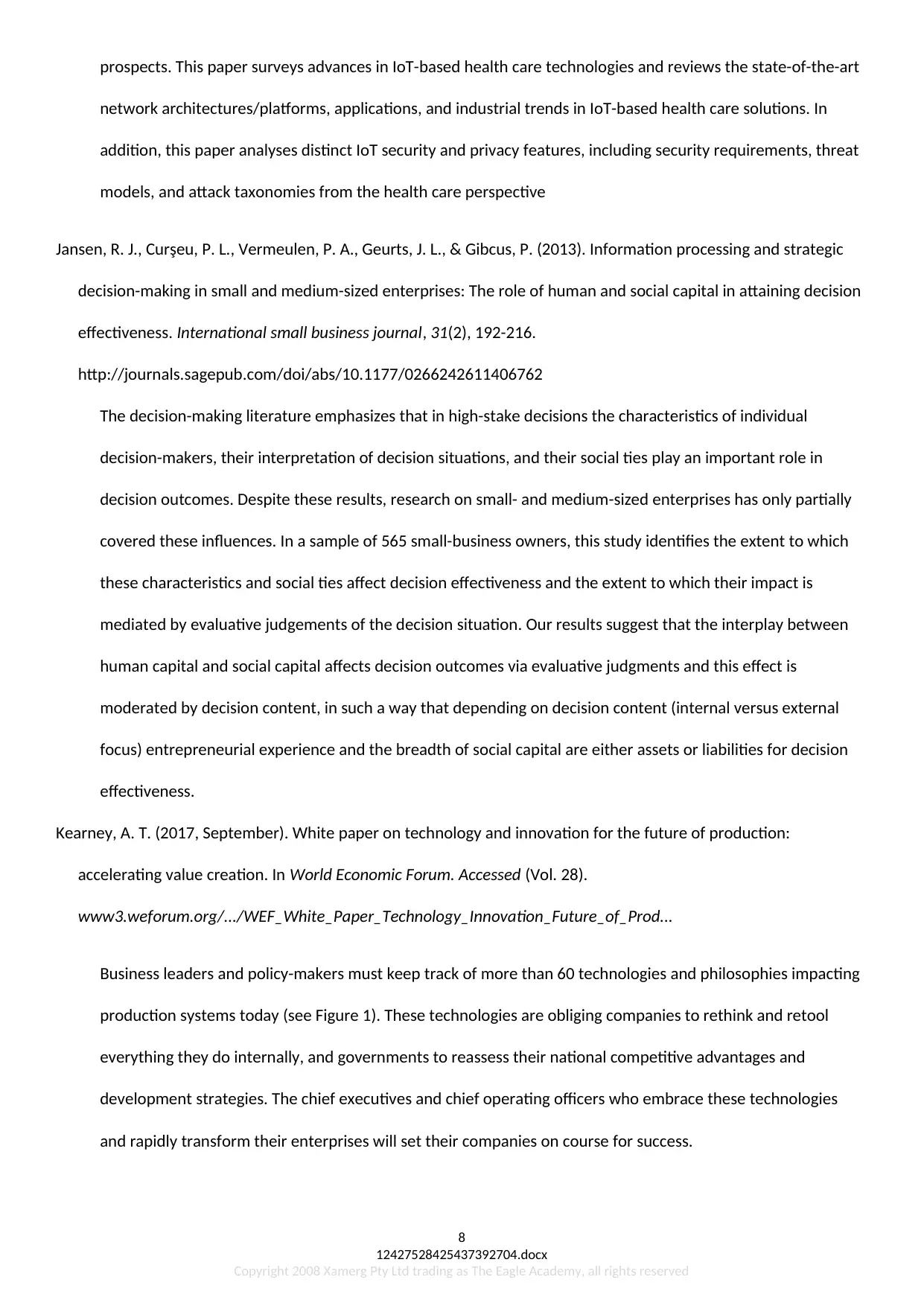
prospects. This paper surveys advances in IoT-based health care technologies and reviews the state-of-the-art
network architectures/platforms, applications, and industrial trends in IoT-based health care solutions. In
addition, this paper analyses distinct IoT security and privacy features, including security requirements, threat
models, and attack taxonomies from the health care perspective
Jansen, R. J., Curşeu, P. L., Vermeulen, P. A., Geurts, J. L., & Gibcus, P. (2013). Information processing and strategic
decision-making in small and medium-sized enterprises: The role of human and social capital in attaining decision
effectiveness. International small business journal, 31(2), 192-216.
http://journals.sagepub.com/doi/abs/10.1177/0266242611406762
The decision-making literature emphasizes that in high-stake decisions the characteristics of individual
decision-makers, their interpretation of decision situations, and their social ties play an important role in
decision outcomes. Despite these results, research on small- and medium-sized enterprises has only partially
covered these influences. In a sample of 565 small-business owners, this study identifies the extent to which
these characteristics and social ties affect decision effectiveness and the extent to which their impact is
mediated by evaluative judgements of the decision situation. Our results suggest that the interplay between
human capital and social capital affects decision outcomes via evaluative judgments and this effect is
moderated by decision content, in such a way that depending on decision content (internal versus external
focus) entrepreneurial experience and the breadth of social capital are either assets or liabilities for decision
effectiveness.
Kearney, A. T. (2017, September). White paper on technology and innovation for the future of production:
accelerating value creation. In World Economic Forum. Accessed (Vol. 28).
www3.weforum.org/.../WEF_White_Paper_Technology_Innovation_Future_of_Prod...
Business leaders and policy-makers must keep track of more than 60 technologies and philosophies impacting
production systems today (see Figure 1). These technologies are obliging companies to rethink and retool
everything they do internally, and governments to reassess their national competitive advantages and
development strategies. The chief executives and chief operating officers who embrace these technologies
and rapidly transform their enterprises will set their companies on course for success.
8
12427528425437392704.docx
Copyright 2008 Xamerg Pty Ltd trading as The Eagle Academy, all rights reserved
network architectures/platforms, applications, and industrial trends in IoT-based health care solutions. In
addition, this paper analyses distinct IoT security and privacy features, including security requirements, threat
models, and attack taxonomies from the health care perspective
Jansen, R. J., Curşeu, P. L., Vermeulen, P. A., Geurts, J. L., & Gibcus, P. (2013). Information processing and strategic
decision-making in small and medium-sized enterprises: The role of human and social capital in attaining decision
effectiveness. International small business journal, 31(2), 192-216.
http://journals.sagepub.com/doi/abs/10.1177/0266242611406762
The decision-making literature emphasizes that in high-stake decisions the characteristics of individual
decision-makers, their interpretation of decision situations, and their social ties play an important role in
decision outcomes. Despite these results, research on small- and medium-sized enterprises has only partially
covered these influences. In a sample of 565 small-business owners, this study identifies the extent to which
these characteristics and social ties affect decision effectiveness and the extent to which their impact is
mediated by evaluative judgements of the decision situation. Our results suggest that the interplay between
human capital and social capital affects decision outcomes via evaluative judgments and this effect is
moderated by decision content, in such a way that depending on decision content (internal versus external
focus) entrepreneurial experience and the breadth of social capital are either assets or liabilities for decision
effectiveness.
Kearney, A. T. (2017, September). White paper on technology and innovation for the future of production:
accelerating value creation. In World Economic Forum. Accessed (Vol. 28).
www3.weforum.org/.../WEF_White_Paper_Technology_Innovation_Future_of_Prod...
Business leaders and policy-makers must keep track of more than 60 technologies and philosophies impacting
production systems today (see Figure 1). These technologies are obliging companies to rethink and retool
everything they do internally, and governments to reassess their national competitive advantages and
development strategies. The chief executives and chief operating officers who embrace these technologies
and rapidly transform their enterprises will set their companies on course for success.
8
12427528425437392704.docx
Copyright 2008 Xamerg Pty Ltd trading as The Eagle Academy, all rights reserved
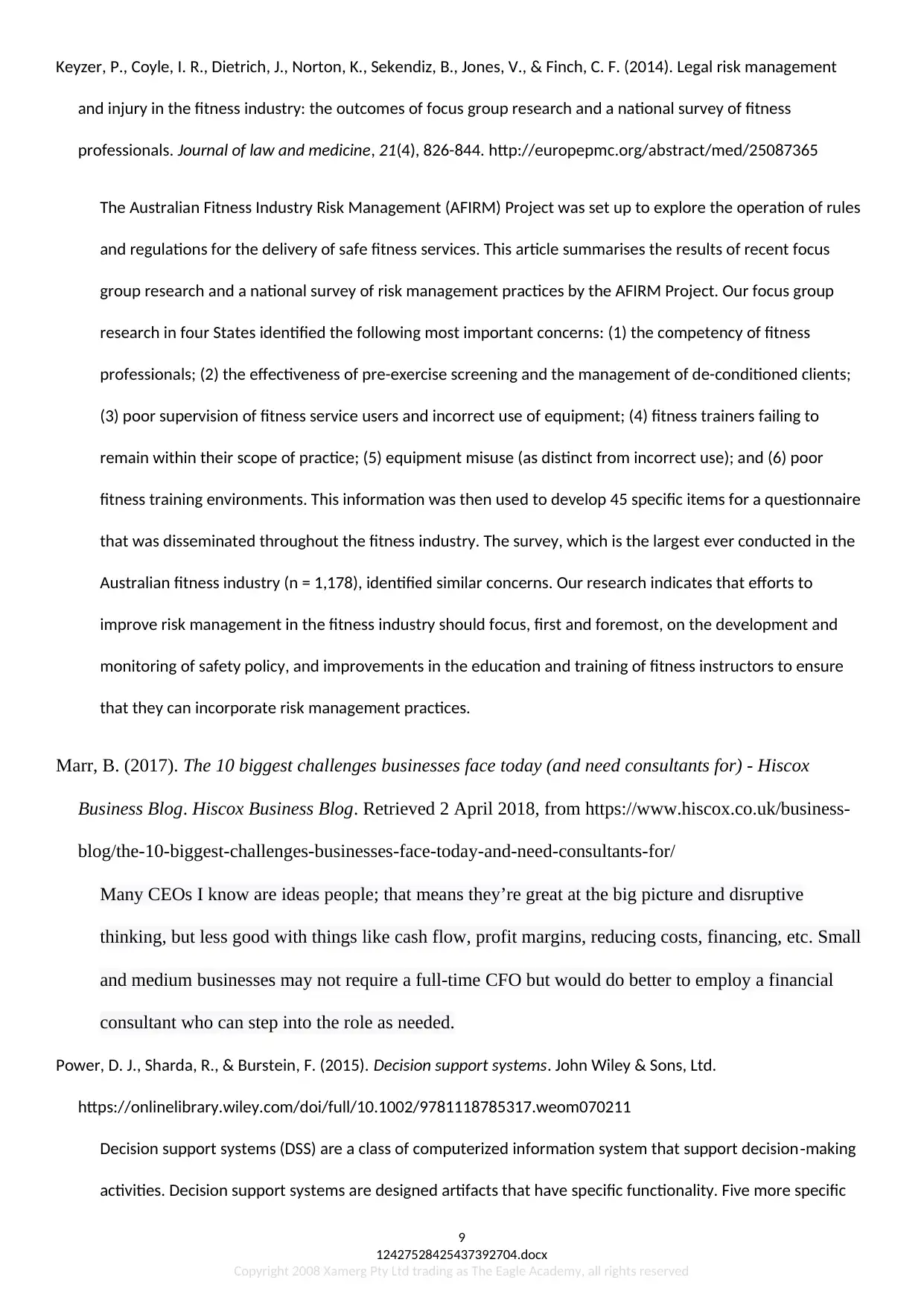
Keyzer, P., Coyle, I. R., Dietrich, J., Norton, K., Sekendiz, B., Jones, V., & Finch, C. F. (2014). Legal risk management
and injury in the fitness industry: the outcomes of focus group research and a national survey of fitness
professionals. Journal of law and medicine, 21(4), 826-844. http://europepmc.org/abstract/med/25087365
The Australian Fitness Industry Risk Management (AFIRM) Project was set up to explore the operation of rules
and regulations for the delivery of safe fitness services. This article summarises the results of recent focus
group research and a national survey of risk management practices by the AFIRM Project. Our focus group
research in four States identified the following most important concerns: (1) the competency of fitness
professionals; (2) the effectiveness of pre-exercise screening and the management of de-conditioned clients;
(3) poor supervision of fitness service users and incorrect use of equipment; (4) fitness trainers failing to
remain within their scope of practice; (5) equipment misuse (as distinct from incorrect use); and (6) poor
fitness training environments. This information was then used to develop 45 specific items for a questionnaire
that was disseminated throughout the fitness industry. The survey, which is the largest ever conducted in the
Australian fitness industry (n = 1,178), identified similar concerns. Our research indicates that efforts to
improve risk management in the fitness industry should focus, first and foremost, on the development and
monitoring of safety policy, and improvements in the education and training of fitness instructors to ensure
that they can incorporate risk management practices.
Marr, B. (2017). The 10 biggest challenges businesses face today (and need consultants for) - Hiscox
Business Blog. Hiscox Business Blog. Retrieved 2 April 2018, from https://www.hiscox.co.uk/business-
blog/the-10-biggest-challenges-businesses-face-today-and-need-consultants-for/
Many CEOs I know are ideas people; that means they’re great at the big picture and disruptive
thinking, but less good with things like cash flow, profit margins, reducing costs, financing, etc. Small
and medium businesses may not require a full-time CFO but would do better to employ a financial
consultant who can step into the role as needed.
Power, D. J., Sharda, R., & Burstein, F. (2015). Decision support systems. John Wiley & Sons, Ltd.
https://onlinelibrary.wiley.com/doi/full/10.1002/9781118785317.weom070211
Decision support systems (DSS) are a class of computerized information system that support decision‐making
activities. Decision support systems are designed artifacts that have specific functionality. Five more specific
9
12427528425437392704.docx
Copyright 2008 Xamerg Pty Ltd trading as The Eagle Academy, all rights reserved
and injury in the fitness industry: the outcomes of focus group research and a national survey of fitness
professionals. Journal of law and medicine, 21(4), 826-844. http://europepmc.org/abstract/med/25087365
The Australian Fitness Industry Risk Management (AFIRM) Project was set up to explore the operation of rules
and regulations for the delivery of safe fitness services. This article summarises the results of recent focus
group research and a national survey of risk management practices by the AFIRM Project. Our focus group
research in four States identified the following most important concerns: (1) the competency of fitness
professionals; (2) the effectiveness of pre-exercise screening and the management of de-conditioned clients;
(3) poor supervision of fitness service users and incorrect use of equipment; (4) fitness trainers failing to
remain within their scope of practice; (5) equipment misuse (as distinct from incorrect use); and (6) poor
fitness training environments. This information was then used to develop 45 specific items for a questionnaire
that was disseminated throughout the fitness industry. The survey, which is the largest ever conducted in the
Australian fitness industry (n = 1,178), identified similar concerns. Our research indicates that efforts to
improve risk management in the fitness industry should focus, first and foremost, on the development and
monitoring of safety policy, and improvements in the education and training of fitness instructors to ensure
that they can incorporate risk management practices.
Marr, B. (2017). The 10 biggest challenges businesses face today (and need consultants for) - Hiscox
Business Blog. Hiscox Business Blog. Retrieved 2 April 2018, from https://www.hiscox.co.uk/business-
blog/the-10-biggest-challenges-businesses-face-today-and-need-consultants-for/
Many CEOs I know are ideas people; that means they’re great at the big picture and disruptive
thinking, but less good with things like cash flow, profit margins, reducing costs, financing, etc. Small
and medium businesses may not require a full-time CFO but would do better to employ a financial
consultant who can step into the role as needed.
Power, D. J., Sharda, R., & Burstein, F. (2015). Decision support systems. John Wiley & Sons, Ltd.
https://onlinelibrary.wiley.com/doi/full/10.1002/9781118785317.weom070211
Decision support systems (DSS) are a class of computerized information system that support decision‐making
activities. Decision support systems are designed artifacts that have specific functionality. Five more specific
9
12427528425437392704.docx
Copyright 2008 Xamerg Pty Ltd trading as The Eagle Academy, all rights reserved
⊘ This is a preview!⊘
Do you want full access?
Subscribe today to unlock all pages.

Trusted by 1+ million students worldwide

Decision Support System types include i) communications‐driven, ii) data‐driven, iii) document‐driven, iv)
knowledge‐driven, and v) model‐driven systems. Communications technologies are central to
communications‐driven DSS for supporting decision‐making. Data‐driven DSS provide access to large data
stores and analytics to create information. Document‐driven DSS use documents to provide information for
decision making. Knowledge‐driven DSS are sometimes generically called expert systems or recommender
systems. Model‐driven DSS use quantitative models for functionality and have been called model
‐oriented
DSS and computationally oriented DSS.
Raciti, M. M., Ward, T., & Dagger, T. S. (2013). The effect of relationship desire on consumer-to-business
relationships. European Journal of Marketing, 47(3/4), 615-634.
https://www.emeraldinsight.com/doi/abs/10.1108/03090561311297490
Findings
– Analysis revealed that consumers desire to participate in a relationship influenced their level of
motivation, degree of confidence and these, in turn, impacted on the consumers' sense of affiliation with
the service provider. A consumer's sense of affiliation subsequently influenced the strength of their
relationship and their level of satisfaction with the relationship.
Ribeiro, L. C., Rodriguez, R. Y., & Vicente, M. (2016). Informal social network and technical knowledge transfer in
r&d. REAd. Revista Eletrônica de Administração (Porto Alegre), 22(3), 280-311. http://www.scielo.br/scielo.php?
pid=S1413-23112016000300280&script=sci_arttext
There is a growing interest in Knowledge Management (KM) in the corporate world. The company’s ability to
compile the accrued knowledge, organize are valued by what they know. Knowing the organization, its culture
and how your employees relate themselves formal or informally, became fundamental for elaborating
strategies for an efficient KM application. The formal relationship is easily recognized in the organizational
charts of any organization type; however, the informal relationships, which generate high synergy, are not
much explored as a manner of knowledge sharing. The present article has the purpose of presenting how the
interpersonal relationship occurs in a general management of CENPES (Research Centre Leopoldo Américo
Miguez de Mello) which develops basic engineering projects for the oil and gas industry, identifying its key
10
12427528425437392704.docx
Copyright 2008 Xamerg Pty Ltd trading as The Eagle Academy, all rights reserved
knowledge‐driven, and v) model‐driven systems. Communications technologies are central to
communications‐driven DSS for supporting decision‐making. Data‐driven DSS provide access to large data
stores and analytics to create information. Document‐driven DSS use documents to provide information for
decision making. Knowledge‐driven DSS are sometimes generically called expert systems or recommender
systems. Model‐driven DSS use quantitative models for functionality and have been called model
‐oriented
DSS and computationally oriented DSS.
Raciti, M. M., Ward, T., & Dagger, T. S. (2013). The effect of relationship desire on consumer-to-business
relationships. European Journal of Marketing, 47(3/4), 615-634.
https://www.emeraldinsight.com/doi/abs/10.1108/03090561311297490
Findings
– Analysis revealed that consumers desire to participate in a relationship influenced their level of
motivation, degree of confidence and these, in turn, impacted on the consumers' sense of affiliation with
the service provider. A consumer's sense of affiliation subsequently influenced the strength of their
relationship and their level of satisfaction with the relationship.
Ribeiro, L. C., Rodriguez, R. Y., & Vicente, M. (2016). Informal social network and technical knowledge transfer in
r&d. REAd. Revista Eletrônica de Administração (Porto Alegre), 22(3), 280-311. http://www.scielo.br/scielo.php?
pid=S1413-23112016000300280&script=sci_arttext
There is a growing interest in Knowledge Management (KM) in the corporate world. The company’s ability to
compile the accrued knowledge, organize are valued by what they know. Knowing the organization, its culture
and how your employees relate themselves formal or informally, became fundamental for elaborating
strategies for an efficient KM application. The formal relationship is easily recognized in the organizational
charts of any organization type; however, the informal relationships, which generate high synergy, are not
much explored as a manner of knowledge sharing. The present article has the purpose of presenting how the
interpersonal relationship occurs in a general management of CENPES (Research Centre Leopoldo Américo
Miguez de Mello) which develops basic engineering projects for the oil and gas industry, identifying its key
10
12427528425437392704.docx
Copyright 2008 Xamerg Pty Ltd trading as The Eagle Academy, all rights reserved
Paraphrase This Document
Need a fresh take? Get an instant paraphrase of this document with our AI Paraphraser

actors through the Social Network Analysis (SNA). For data source, a survey was performed through
questionnaires applied for the employees of the studied unit.
Rosemann, M., & vom Brocke, J. (2015). The six core elements of business process management. In Handbook on
business process management 1 (pp. 105-122). Springer Berlin Heidelberg.
https://link.springer.com/chapter/10.1007%2F978-3-642-45100-3_5
This chapter introduces a consolidating framework that provides structure and decomposes BPM into six
essential elements. Drawing from research in the field of maturity models and its application in a number of
organizations all over the globe, we suggest the following six core elements of BPM: strategic alignment,
governance, methods, information technology, people, and culture. These six elements serve as the core
structure for this BPM Handbook.
Kulturel-Konak, S., & Konak, A. (2013). Linear programming based genetic algorithm for the unequal area facility
layout problem. International Journal of Production Research, 51(14), 4302-4324.
https://www.tandfonline.com/doi/abs/10.1080/00207543.2013.774481
The facility layout problem (FLP) is generally defined as locating a set of departments in a facility
with a given dimension. In this paper, a hybrid genetic algorithm (GA)/linear programming (LP)
approach is proposed to solve the FLP on the continuous plane with unequal area departments. This
version of the FLP is very difficult to solve optimally due to the large number of binary decision
variables in mixed integer programming (MIP) models as well as the lack of tight lower bounds. In
this paper, a new encoding scheme, called the location/shape representation, is developed to represent
layouts in a GA. This encoding scheme represents relative department positions in the facility based
on the centroids and orientations of departments.
Step 5: Reading Articles and Highlighting Key Points
Al-Matar, N. (2017). Theories and Applications Related to Queuing Systems (1st ed., pp. 14-17). Saudi
Arabia: Management Information System Department. Retrieved from
http://www.worldresearchlibrary.org/up_proc/pdf/571-148612662907-10.pdf
11
12427528425437392704.docx
Copyright 2008 Xamerg Pty Ltd trading as The Eagle Academy, all rights reserved
questionnaires applied for the employees of the studied unit.
Rosemann, M., & vom Brocke, J. (2015). The six core elements of business process management. In Handbook on
business process management 1 (pp. 105-122). Springer Berlin Heidelberg.
https://link.springer.com/chapter/10.1007%2F978-3-642-45100-3_5
This chapter introduces a consolidating framework that provides structure and decomposes BPM into six
essential elements. Drawing from research in the field of maturity models and its application in a number of
organizations all over the globe, we suggest the following six core elements of BPM: strategic alignment,
governance, methods, information technology, people, and culture. These six elements serve as the core
structure for this BPM Handbook.
Kulturel-Konak, S., & Konak, A. (2013). Linear programming based genetic algorithm for the unequal area facility
layout problem. International Journal of Production Research, 51(14), 4302-4324.
https://www.tandfonline.com/doi/abs/10.1080/00207543.2013.774481
The facility layout problem (FLP) is generally defined as locating a set of departments in a facility
with a given dimension. In this paper, a hybrid genetic algorithm (GA)/linear programming (LP)
approach is proposed to solve the FLP on the continuous plane with unequal area departments. This
version of the FLP is very difficult to solve optimally due to the large number of binary decision
variables in mixed integer programming (MIP) models as well as the lack of tight lower bounds. In
this paper, a new encoding scheme, called the location/shape representation, is developed to represent
layouts in a GA. This encoding scheme represents relative department positions in the facility based
on the centroids and orientations of departments.
Step 5: Reading Articles and Highlighting Key Points
Al-Matar, N. (2017). Theories and Applications Related to Queuing Systems (1st ed., pp. 14-17). Saudi
Arabia: Management Information System Department. Retrieved from
http://www.worldresearchlibrary.org/up_proc/pdf/571-148612662907-10.pdf
11
12427528425437392704.docx
Copyright 2008 Xamerg Pty Ltd trading as The Eagle Academy, all rights reserved
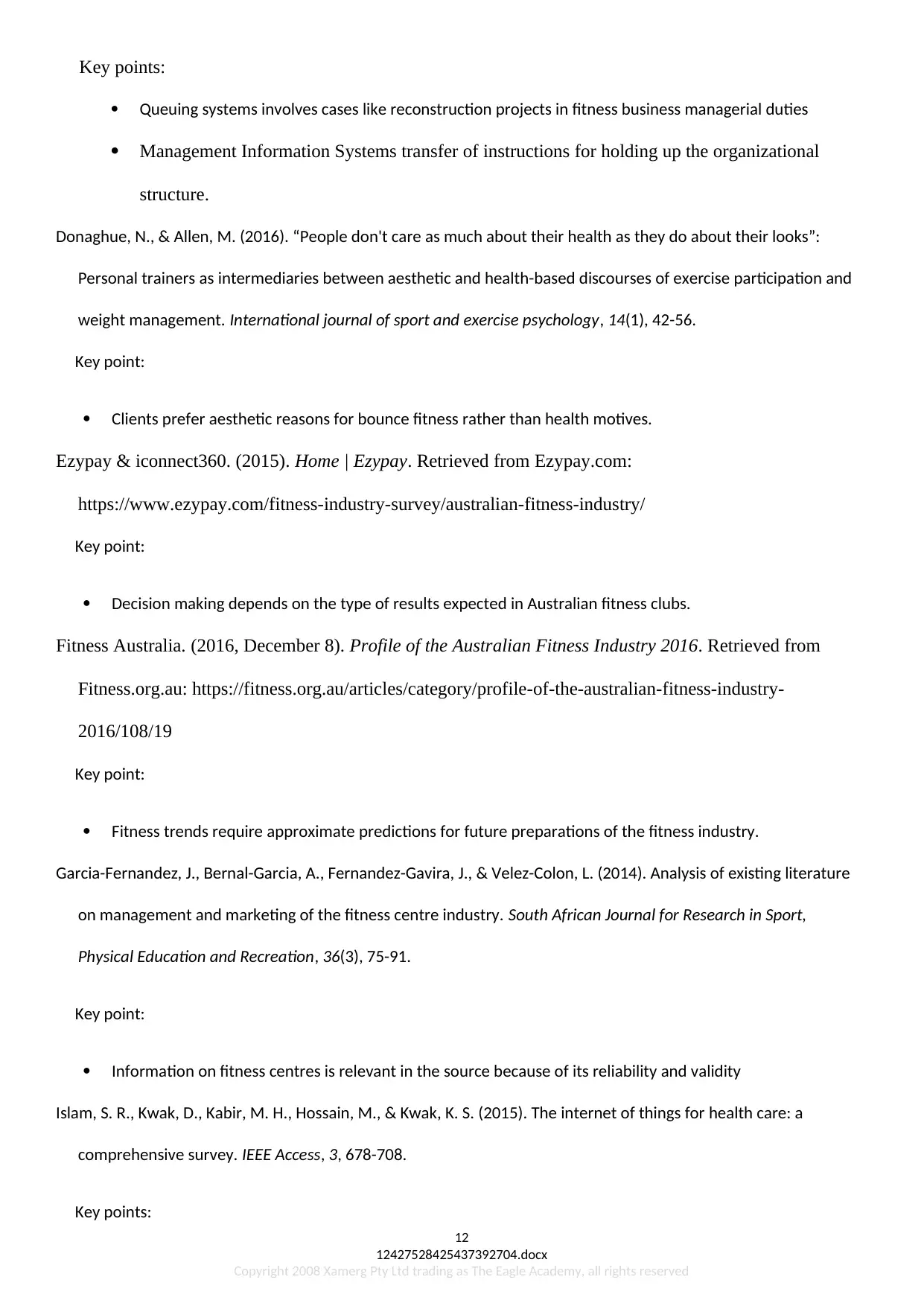
Key points:
Queuing systems involves cases like reconstruction projects in fitness business managerial duties
Management Information Systems transfer of instructions for holding up the organizational
structure.
Donaghue, N., & Allen, M. (2016). “People don't care as much about their health as they do about their looks”:
Personal trainers as intermediaries between aesthetic and health-based discourses of exercise participation and
weight management. International journal of sport and exercise psychology, 14(1), 42-56.
Key point:
Clients prefer aesthetic reasons for bounce fitness rather than health motives.
Ezypay & iconnect360. (2015). Home | Ezypay. Retrieved from Ezypay.com:
https://www.ezypay.com/fitness-industry-survey/australian-fitness-industry/
Key point:
Decision making depends on the type of results expected in Australian fitness clubs.
Fitness Australia. (2016, December 8). Profile of the Australian Fitness Industry 2016. Retrieved from
Fitness.org.au: https://fitness.org.au/articles/category/profile-of-the-australian-fitness-industry-
2016/108/19
Key point:
Fitness trends require approximate predictions for future preparations of the fitness industry.
Garcia-Fernandez, J., Bernal-Garcia, A., Fernandez-Gavira, J., & Velez-Colon, L. (2014). Analysis of existing literature
on management and marketing of the fitness centre industry. South African Journal for Research in Sport,
Physical Education and Recreation, 36(3), 75-91.
Key point:
Information on fitness centres is relevant in the source because of its reliability and validity
Islam, S. R., Kwak, D., Kabir, M. H., Hossain, M., & Kwak, K. S. (2015). The internet of things for health care: a
comprehensive survey. IEEE Access, 3, 678-708.
Key points:
12
12427528425437392704.docx
Copyright 2008 Xamerg Pty Ltd trading as The Eagle Academy, all rights reserved
Queuing systems involves cases like reconstruction projects in fitness business managerial duties
Management Information Systems transfer of instructions for holding up the organizational
structure.
Donaghue, N., & Allen, M. (2016). “People don't care as much about their health as they do about their looks”:
Personal trainers as intermediaries between aesthetic and health-based discourses of exercise participation and
weight management. International journal of sport and exercise psychology, 14(1), 42-56.
Key point:
Clients prefer aesthetic reasons for bounce fitness rather than health motives.
Ezypay & iconnect360. (2015). Home | Ezypay. Retrieved from Ezypay.com:
https://www.ezypay.com/fitness-industry-survey/australian-fitness-industry/
Key point:
Decision making depends on the type of results expected in Australian fitness clubs.
Fitness Australia. (2016, December 8). Profile of the Australian Fitness Industry 2016. Retrieved from
Fitness.org.au: https://fitness.org.au/articles/category/profile-of-the-australian-fitness-industry-
2016/108/19
Key point:
Fitness trends require approximate predictions for future preparations of the fitness industry.
Garcia-Fernandez, J., Bernal-Garcia, A., Fernandez-Gavira, J., & Velez-Colon, L. (2014). Analysis of existing literature
on management and marketing of the fitness centre industry. South African Journal for Research in Sport,
Physical Education and Recreation, 36(3), 75-91.
Key point:
Information on fitness centres is relevant in the source because of its reliability and validity
Islam, S. R., Kwak, D., Kabir, M. H., Hossain, M., & Kwak, K. S. (2015). The internet of things for health care: a
comprehensive survey. IEEE Access, 3, 678-708.
Key points:
12
12427528425437392704.docx
Copyright 2008 Xamerg Pty Ltd trading as The Eagle Academy, all rights reserved
⊘ This is a preview!⊘
Do you want full access?
Subscribe today to unlock all pages.

Trusted by 1+ million students worldwide
1 out of 23
Related Documents
Your All-in-One AI-Powered Toolkit for Academic Success.
+13062052269
info@desklib.com
Available 24*7 on WhatsApp / Email
![[object Object]](/_next/static/media/star-bottom.7253800d.svg)
Unlock your academic potential
Copyright © 2020–2025 A2Z Services. All Rights Reserved. Developed and managed by ZUCOL.
